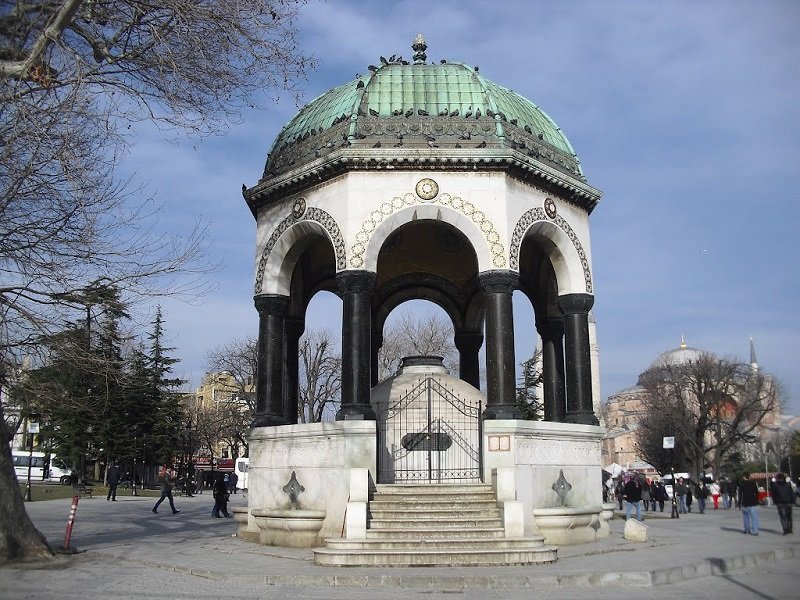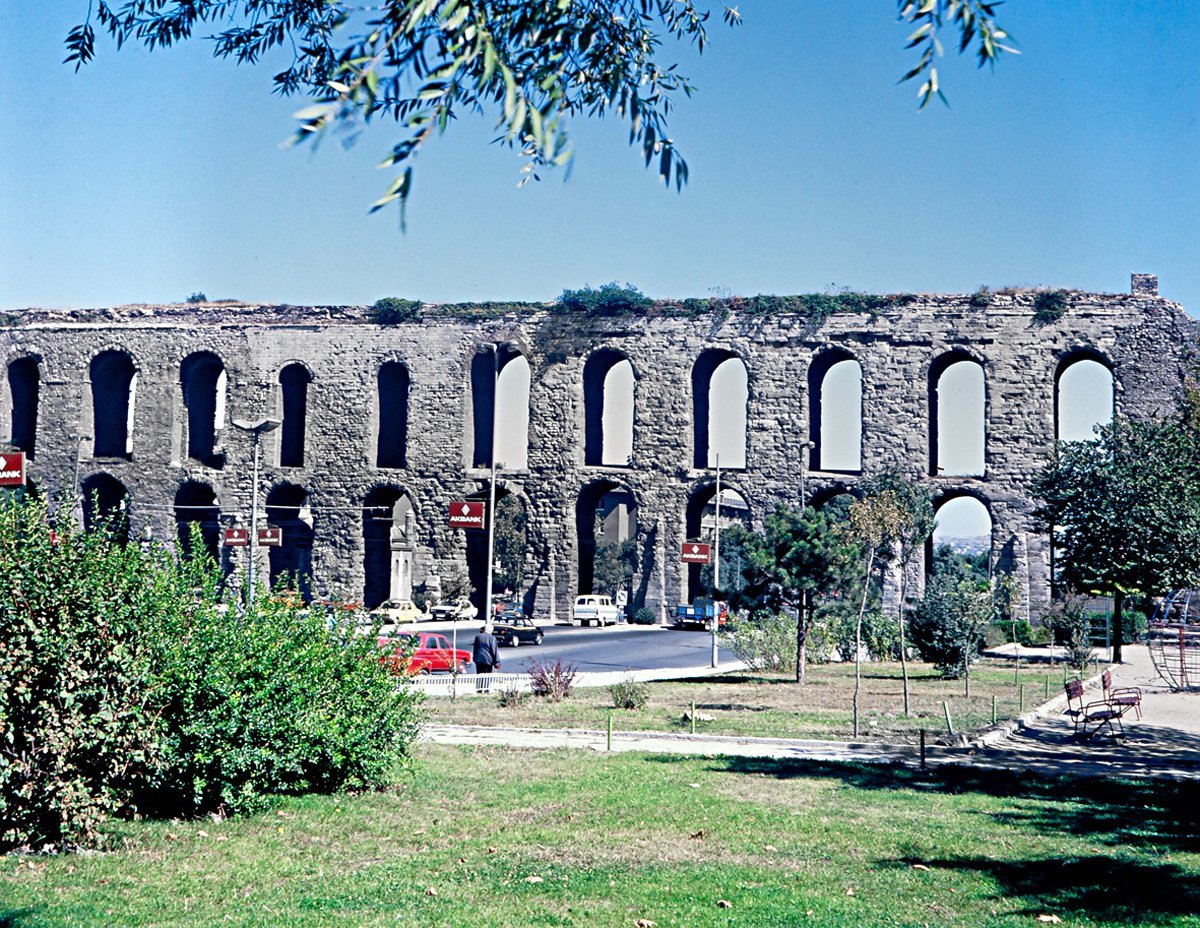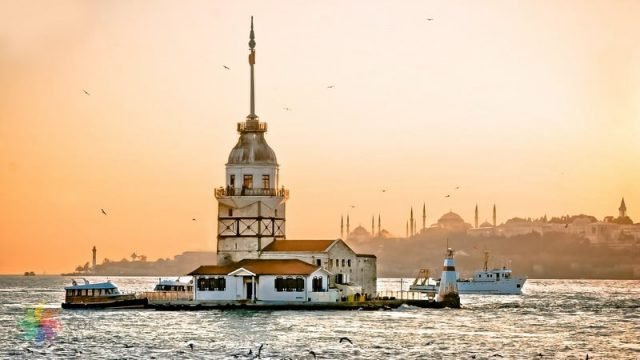The Cistern Basilica, now a museum, is one of the most majestic buildings that has been preserved to this day. It was built by Emperor Justinian in 532, it is a structure that occupies a large area, measuring 70 m. x 140 m. and contains 80,000 m³ of water.
 The cistern was built to supply water to the Byzantine palace and other surrounding buildings. The water was transported via aqueducts from the Belgrade forest (19 km from Istanbul).
The cistern was built to supply water to the Byzantine palace and other surrounding buildings. The water was transported via aqueducts from the Belgrade forest (19 km from Istanbul).
The cistern has 336 columns that reach a height of 8 m. Under two columns of the cistern are the heads of Medusa, one upside down, the other crooked. According to historians, these heads were placed either to raise two columns that were lower than the others, or to protect the cistern from evil eyes. In mythology the Medusa is one of the three gorgons who has the ability to petrify anyone who looks at her.
During the restoration works started in 1985, several tons of mud were removed from the cistern, while keeping the water level low, a walkway was built that allows you to visit the cistern until the end. Nowadays the cistern can be visited listening to music and being accompanied by a play of lights.
Hippodrome square is considered the heart of Istanbul’s tourism. The ancient monuments in the middle of the square and the buildings surrounding it are the most important historical works of Istanbul.
Construction work on the Hippodrome began in 203 under the Emperor Septimius Severus, and ended in 330 under the Emperor Constantine the Great, given its dimensions of 400 x 140 m. it was one of the largest in the ancient world, after the Circus Maximus in Rome.
The Hippodrome was the scene of sporting events, sometimes of bloody riots, fights between gladiators, chariot races and various entertainment. In the central part of the Hippodrome there were statues, columns and monuments from all parts of the world. Only three of these have managed to reach our days, the others have either been destroyed or transported to other cities: the Egyptian Obelisk, the Serpentine Column, the Constantine Column and the German Fountain.
Museum of Islamic and Turkish Arts is located in front of the Sultanahmet Mosque, it was the palace of the grand vizier Ibrahim Pasha. Ibrahim Pasha was the only person who, although not belonging to the sultan’s family, still had a palace of his own. In 1520 the palace was given to him by the Sultan Suleiman the Magnificent. Throughout history it was used as a prison, barracks, tax office, residence of the embassies and eventually left in ruins.
The palace was restored in 1970 and the collections including manuscripts, objects in stone, terracotta, metal and wood were transported there. The richest collection of the museum is that of handmade rugs of incredible dimensions. In 1984 it was awarded by the European Council.
Istanbul Archaeological Museums are located near the Topkapı Palace. The museum buildings are one of the 5 largest museums in the world and includes three museums: the Archaeological Museum, the Museum of the Ancient East and the Tile Museum.
The 800,000 works exhibited in the rooms of the Istanbul Archaeological Museum, out of a total of 2,500,000 scattered throughout Turkey, mostly belong to the Hittite, Greek, Roman, Byzantine and Ottoman periods.
Circled (or Burned) Column, 37 m high, built in the 4th century by the Emperor Constantine the Great, on top it bore a bronze statue of the Emperor of the Constantino forum (it was very close to the Hippodrome) only this column remains.
It is assumed that under the column there are some sacred relics of christianity (the pieces of the real Cross, the stone from which Moses made the water come out by breaking it with his stick, etc.) brought by the mother of the Emperor Constantine during the visit to Jerusalem.
Aqueduct of Valens built in 375 by the Byzantine Emperor Valens. Built near the Mosque of Sultan Suleiman the Magnificent, it was used to bring water to the Basilica Cistern and the Nymphaion fountain.
Originally it was 1 km long, currently about 600 m remain standing. It has a height of 20 m. and ran for 1500 years, it was renovated in the 17th century by the Ottomans.
Galata Tower is visible from almost all parts of the city, it is 61 m high. It is known that in the 5th century in this place there was a tower called “the Tower of Jesus”. The current tower was built by the Genoese between 1348-49.
Undoubtedly, its splendid panorama is the most important reason for attracting visitors. The tower is located on a hill overlooking the Bosphorus, the Golden Horn and the Sea of Marmara. It is possible to reach its terrace by taking the lift.
Maiden’s Tower (or Leandro) is one of the symbols of Istanbul. It is located in the middle of the Bosphorus on the rocks at a distance of 200 m. from the coast. The Byzantine emperor enclosed her daughter in the tower to protect her from her wickedness. Unfortunately, from the basket of apples brought to the tower by a witch, a snake came out and bit the girl. The predictions of the oracles came true and the princess died. For this reason it is called “the Tower of the Maiden”.
The historical sources speak a fortress built by Alcibiades, in the 5th century. B.C. (during the wars between the Athenians and the Spartans). In the 12th century the Byzantine emperor Manuel Comneno ordered the construction of a defense fortress.
After the conquest of Istanbul, Sultan Mehmet II. the Conqueror commissioned the construction of a new tower. It is currently transformed into a romantic bar-restaurant.
Military Museum which houses Ottoman weapons and military uniforms, also houses the large tents used by the Ottoman armies during the war campaigns. The military orchestra (mehter takımı) performs anthems of Ottoman military music between 3 and 4 in the afternoon.
European Fortress was built in 1542 by Sultan Mehmet the Conqueror, before besieging Constantinople in 1453, to prevent aid that could reach the Byzantines from the Black Sea and the Danube. The fortress is composed of 3 large towers, in order to speed up the construction each of the towers was entrusted to the responsibility of a pasha. Inside the walls there is a cannon museum and an amphitheater which is used in the summer months for concerts and music festivals.
Anatolian Fortress instead, which is located in front of the European Fortress, was built in 1393 by Sultan Yıldırım Beyazıt, grandfather of Sultan Mehmet the Conqueror, during the first siege of the Turks.















RECENT COMMENTS